Tying the Beastmaster General
The instructions given above are for a chartreuse/white
Beastmaster General but I tie this up in many colors. Among my other
favorites are all-white, all-black, blue/white, yellow/white, yellow/red,
red/white, and chartreuse/grizzly. While I tie this fly mostly using
wide neck hackle I also tie versions of it using narrower saddles
as well. I should also point out that if you tied this fly without
the deer hair head and collar and added a collar of mallard in front
of the forward marabou hackle you would then have a fly known simply
as the Beastmaster.
step 1-2
 Tie in Tail wing and overlay of flash. Trim excess. Tie in Tail wing and overlay of flash. Trim excess. 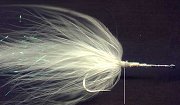 Tie
in two white blood marabou feathers and wind them together taking two
or three turns around the shank just in front of the tailwing. Trim
excess. Tie
in two white blood marabou feathers and wind them together taking two
or three turns around the shank just in front of the tailwing. Trim
excess.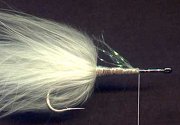 Tie
in six-seven strands of Glimmer (you may use another sturdy body
material if you don't have Glimmer) and wind forward to form a body.
Stop your winding approximately 1/3 the hook shank's length back from
the eye of the hook. Tie
in six-seven strands of Glimmer (you may use another sturdy body
material if you don't have Glimmer) and wind forward to form a body.
Stop your winding approximately 1/3 the hook shank's length back from
the eye of the hook.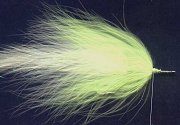 Tie
in three chartreuse blood marabou feathers and wind them together
taking two or three turns around the shank just in front of the
tailwing, being sure to leave plenty of room for your deer hair collar
and head. (It's important to remember your head will in general be
approximately one-third of the hook shank.) Trim excess. Tie
in three chartreuse blood marabou feathers and wind them together
taking two or three turns around the shank just in front of the
tailwing, being sure to leave plenty of room for your deer hair collar
and head. (It's important to remember your head will in general be
approximately one-third of the hook shank.) Trim excess.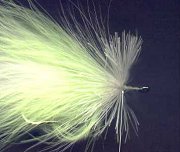 Take
a small clump of white deer hair (approx. 3" long), clean it with a
brush, and tie it in on the far side of the shank just in front of the
marabou hackle, being sure to make the collar points approx. two inches
long. Take another clump of the same size, clean this, and tie it in on
the near side of of the shank so that these points are about the same
length as those on the opposite side. When both sets of hair are tightly
secured, push the remaining forward strands of hair back and take a few
turns of thread in front of them to keep them in that position (this
will now become the rear of your head). Take
a small clump of white deer hair (approx. 3" long), clean it with a
brush, and tie it in on the far side of the shank just in front of the
marabou hackle, being sure to make the collar points approx. two inches
long. Take another clump of the same size, clean this, and tie it in on
the near side of of the shank so that these points are about the same
length as those on the opposite side. When both sets of hair are tightly
secured, push the remaining forward strands of hair back and take a few
turns of thread in front of them to keep them in that position (this
will now become the rear of your head).  Move
your tying thread forward three or four turns in front of the deer hair
butts. Now take a larger clump of white deer, clean it with brush or
comb--very important!--and tie it in on top of the shank with the butts
facing the rear of the fly. With thread pressure move this clump now to
the bottom of the shank. Tighten thread with a tap or two of your
fingers on the bobbin and then with tight windings to the rear
distribute the hairs around the shank of the hook to form the rear
portion of the head. Now wind thread forward--again tight turns--until
hair is evenly distributed around the hook shank all the way up to the
eye of the hook. For more detailed instructions on my unique method of
turning hair into hackle, see my book Scratching the Surface. Move
your tying thread forward three or four turns in front of the deer hair
butts. Now take a larger clump of white deer, clean it with brush or
comb--very important!--and tie it in on top of the shank with the butts
facing the rear of the fly. With thread pressure move this clump now to
the bottom of the shank. Tighten thread with a tap or two of your
fingers on the bobbin and then with tight windings to the rear
distribute the hairs around the shank of the hook to form the rear
portion of the head. Now wind thread forward--again tight turns--until
hair is evenly distributed around the hook shank all the way up to the
eye of the hook. For more detailed instructions on my unique method of
turning hair into hackle, see my book Scratching the Surface.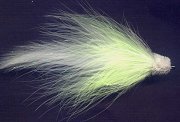 Trim deer hair head to desired shape. Trim deer hair head to desired shape. |
||||||||||||||||||
... angling for two of the more challenging piscatorial predators in the Garden State.
Monday, September 30, 2013
Tying the Beastmaster General by Jack Gartside
Friday, September 20, 2013
Fall is upon us
and I was thinking about our pups long gone:
Caffeine (aka Beanie)
Espresso (aka Pressy) and
Scooby (aka knucklehead or dribble-drawers)
here are espresso and scooby
of course, here is Jamin "torturing" Espresso:
Caffeine (aka Beanie)
Espresso (aka Pressy) and
Scooby (aka knucklehead or dribble-drawers)
here are espresso and scooby
of course, here is Jamin "torturing" Espresso:
Wednesday, September 11, 2013
9/11
Where were you?
I was driving from my home, enroute to work at AT&T Bell Labs, with a quick stop at the United Teletech Federal Credit Union.
On the radio, I heard the report of "a plane" crashing into the World Trade Center:
8:46:30[10] Flight 11 crashes at roughly 466 mph (790 km/h or 219m/s or 425 knots) into the north face of the North Tower (1 WTC) of the World Trade Center, between floors 93 and 99.
I thought, honestly, "terrorist" immediately.
It was a crystal clear sky, bluebird day. There is no accidental way to hit a tower like that.
I was standing in line, watching the news on the screen in the CU lobby when the second plane hit.
9:03:02: Flight 175 crashes at about 590 mph (950 km/h, 264 m/s or 513 knots) into the south face of the South Tower (2 WTC) of the World Trade Center, between floors 77 and 85.[15]
GOD BLESS THE USA!
https://www.youtube.com/watch?v=c8C7i9kdEf8&feature=player_embedded
I was driving from my home, enroute to work at AT&T Bell Labs, with a quick stop at the United Teletech Federal Credit Union.
On the radio, I heard the report of "a plane" crashing into the World Trade Center:
8:46:30[10] Flight 11 crashes at roughly 466 mph (790 km/h or 219m/s or 425 knots) into the north face of the North Tower (1 WTC) of the World Trade Center, between floors 93 and 99.
I thought, honestly, "terrorist" immediately.
It was a crystal clear sky, bluebird day. There is no accidental way to hit a tower like that.
I was standing in line, watching the news on the screen in the CU lobby when the second plane hit.
9:03:02: Flight 175 crashes at about 590 mph (950 km/h, 264 m/s or 513 knots) into the south face of the South Tower (2 WTC) of the World Trade Center, between floors 77 and 85.[15]
GOD BLESS THE USA!
https://www.youtube.com/watch?v=c8C7i9kdEf8&feature=player_embedded
If The Sun Doesn’t Blast It, Comet ISON Will Soon Light Up The Sky

Educators have a different take.
“It’s called Comet ISON,” said Jim O’Leary of the Maryland Science Center.
NASA provided an image of ISON (above). It has a small head and a big tail.
“That tail can get tens of millions of miles long, so it’s huge,” O’Leary said.
But in its middle, it’s just dirt and ice three miles across.
Three miles is large enough to comfortably fit between the shores spanned by the Bay Bridge and its approach ramps.
“It could be the comet of the century,” O’ Leary said. “That is what some people are calling it, and we’re not that far into the century you know.”
It’s certain to light up the winter sky. That is, unless it doesn’t. They don’t know if the sun will blast it to shreds.
“It’s only passing through one diameter away from the sun, 700,000 miles, through the hot corona. That might be enough to blast it apart,” O’Leary said.
In that case, it could turn into smaller comets or disappear completely.
And if it doesn’t bust apart it will be visible for weeks, from December in through January.
The Maryland Science Center expects to have special programs if the comet is as visible as they hope it to be.
http://baltimore.cbslocal.com/2013/09/10/if-the-sun-doesnt-blast-it-comet-ison-will-soon-light-up-the-sky/
Tuesday, September 10, 2013
The Launch
well, I was too young for Mercury and most of Apollo, missed all the Shuttle launches, but finally got to see a live rocket heading toward the moon:

NASA rocket launch to the moon visible to East Coast tonight
The
launch of LADEE, NASA's new lunar exploration mission, will take place
at 11:27 p.m. ET from the agency's new Wallops Flight Facility in
Virginia.

NASA's Lunar Atmosphere and Dust Environment
Explorer will orbit the Moon to gather information on its atmosphere and
surface conditions. It launches from Wallops Island, Va., at 11:27 p.m.
ET.
Subscribe to:
Comments (Atom)




